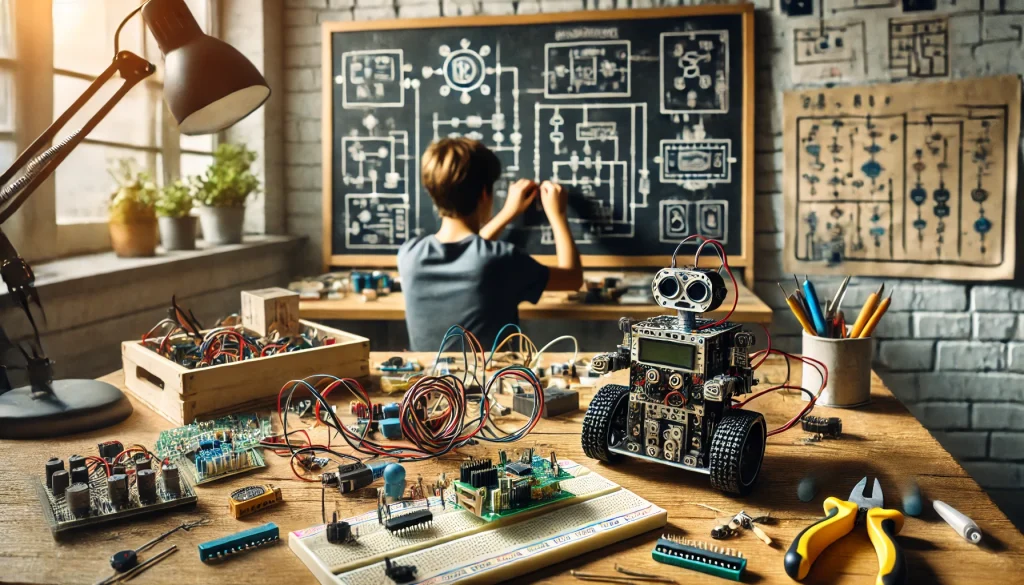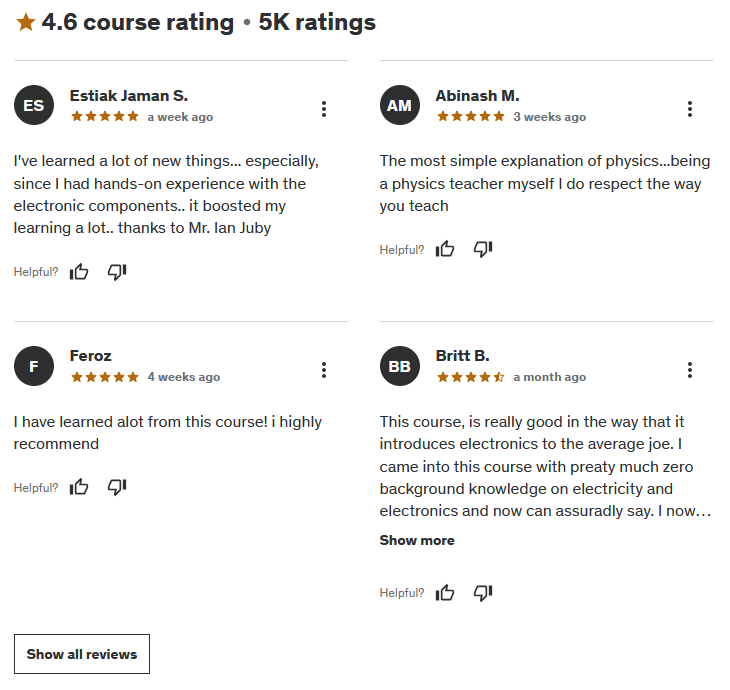If you’re curious about diving into the world of electronics and robotics, then “Electricity & Electronics – Robotics, Learn by Building” is a course that may just be the right starting point. With over 31,000 students already enrolled, this Udemy course combines theory with hands-on learning in a fun and approachable way. Let’s break it down.
Instructor Reputation
Ian Juby, the mind behind this course, is a well-known name in the field of robotics and electronics, and for good reason. With over 30 years of teaching experience, Ian has carved out a niche as both an educator and a hands-on expert in technology. What makes him particularly unique is the broad range of disciplines he’s been involved with. From teaching high school students to working in advanced research and development, Ian has consistently found ways to translate complex ideas into digestible, engaging lessons. His practical experience spans everything from robotics engineering to working with extreme environmental suits that were used on the space shuttle. That’s not something you come across every day!

Ian’s passion for teaching is evident in his approachable, sometimes quirky style. He has a knack for breaking down intimidating subjects into something relatable. In this course, you’ll find him sharing not just technical knowledge but also real-world anecdotes that reflect his years of experience in the field. Whether he’s explaining the fundamentals of circuit design or giving a humorous take on his early days in technology, there’s a level of authenticity to Ian’s teaching that you don’t always get in online courses.
His wide-ranging background doesn’t stop at just technology and robotics. Ian is also a published author and video producer, having written books on video production and even produced educational videos for Canadian railroads. This shows that Ian isn’t just focused on one subject but is a versatile educator who can bring in examples and lessons from a wide variety of fields. And let’s not forget his work on the creation/evolution debate, which adds a layer of depth to his teaching style—he’s someone who isn’t afraid to engage with complex or controversial topics.
Ian’s reputation is also supported by the numbers: over 40,000 students and more than 6,000 reviews across his five courses on Udemy, averaging a 4.6-star rating. These numbers speak volumes about the quality of instruction you can expect. The reviews are largely positive, with many students praising his ability to make even the most complex topics feel manageable and interesting. His energy and enthusiasm are contagious, making it clear that he genuinely cares about his students’ learning journeys.
Course Structure
The course structure of “Electricity & Electronics – Robotics, Learn by Building” is one of its strongest assets, carefully designed to build both foundational knowledge and hands-on skills. If you’re starting with little to no knowledge of electronics or robotics, the course provides a smooth introduction, beginning with the very basics of analog electronics. The progression from simple concepts to more complex applications is methodical, ensuring that students don’t feel overwhelmed as they move forward.

You begin by learning the essentials—soldering, circuit design, and the science behind electricity—before quickly moving into real-world applications. One of the course’s most impressive aspects is its hands-on nature. You won’t just be learning theory here; you’ll be building actual circuits. Projects range from something as simple as a light flasher to more advanced builds like controlling a servo motor using electrical signals from your muscles. This practical approach makes the content far more engaging than a traditional lecture-based course. You’ll immediately see how the theory you learn translates into real, working devices.
Another standout feature is the range of projects you’ll be working on. Each project builds on the last, reinforcing the concepts while keeping things fresh. You’ll start with sound buzzers and gradually move on to more complex systems like bionic motor control. By the end of the course, you will have developed not just the technical know-how to build electronic circuits but also the problem-solving skills to troubleshoot and innovate.
One point worth mentioning is that the course requires some basic tools and parts. However, Ian has thoughtfully included a detailed explanation of what you’ll need in the first lesson, and there’s even an option to purchase an accompanying kit. For beginners who might be nervous about sourcing parts on their own, this is a big help. The course is also self-paced, so if you want to spend extra time on a particularly challenging section or revisit earlier material, you have that flexibility.
The course’s structure extends beyond this single module. As part of a multi-course series, it serves as the foundation for future learning. Once you’re comfortable with the basics, the second module introduces digital electronics, followed by courses on robotic drive systems, 3D printing, and even autonomous robotic systems. This progression makes the course feel more like a comprehensive learning path rather than just a standalone introduction. Each module builds on the last, and by the time you finish the full series, you’ll have a deep and practical understanding of robotics and electronics.
In terms of pacing, students have noted that while the course moves quickly at times, it’s always possible to pause and revisit difficult sections. The course is structured to accommodate different learning styles. While some may breeze through the early lessons, others might take their time with the more challenging concepts, like circuit design or muscle-signal-based motor control. This flexibility allows students to truly absorb the material at their own pace, ensuring a deeper understanding of the subject matter.
Content Quality
The content quality of the “Electricity & Electronics – Robotics, Learn by Building” course is one of its major strengths. The course provides an excellent blend of theory and practice, making it a great fit for hands-on learners. Ian Juby doesn’t just focus on presenting information; he crafts an experience where students can actually apply what they’re learning as they go. The idea of building circuits and components from scratch is not only engaging but also highly beneficial for truly grasping the fundamentals of electronics.

One aspect that sets this course apart from others is how well it integrates various types of content—there’s video instruction, written guides, schematics, and hands-on assignments. Each lesson is designed to reinforce previous ones, so by the time you finish the course, you’ll have built a solid foundation in analog electronics. You’ll not only understand how circuits work but also know how to design and build them from the ground up. This step-by-step approach ensures that students don’t feel lost when they encounter more advanced topics later in the course.
However, the course isn’t perfect, and some students have noted a few shortcomings in the content delivery. A frequent point of feedback is that some sections rely too heavily on simple schematics, without enough detailed visual aids or animations to help students visualize complex concepts. For those who are new to electronics, understanding these diagrams can take a bit of time, and without extra visual context, it might require revisiting sections multiple times. Some students suggested that incorporating more animations or real-world examples of each concept could improve comprehension.
That being said, the practical nature of the content makes up for any shortcomings in the visuals. The projects themselves are well thought out and provide a meaningful way to apply what you’ve learned. The course starts with simpler circuits like light flashers and sound effects, and quickly ramps up to more advanced systems such as controlling a servo motor based on muscle signals. This project-based learning approach keeps things exciting and ensures that you aren’t just passively absorbing information but actively engaging with it.
The course also sets itself up well for continuity. By the end of this module, students will have the foundational knowledge to move on to more complex areas of electronics and robotics. The course ties in nicely with the subsequent modules, which cover digital electronics, robotic drive systems, 3D printing, and autonomous systems. So if you’re serious about pursuing a deeper understanding of robotics, the quality of this introductory module sets you up perfectly for the more advanced courses that follow.
Overall Course Rating – 9/10
When evaluating “Electricity & Electronics – Robotics, Learn by Building” as a whole, it’s clear that this course offers a lot of value, particularly for beginners. On a scale of 1 to 10, I’d give this course a 9/10. It manages to take a complex subject and make it approachable, while also offering enough depth to keep more experienced learners engaged. The combination of hands-on learning, engaging content, and a well-structured course path makes it stand out from other introductory electronics courses.

One of the reasons this course scores so highly is its hands-on approach. Ian Juby has carefully crafted each lesson to be an interactive experience. From building circuits to controlling motors with muscle signals, this is the type of course where you’re not just learning—you’re doing. This interactive component really elevates the learning process. You’re building real-world skills, not just memorizing abstract concepts. This, in turn, makes the knowledge more likely to stick and equips you with practical expertise that can be applied in a wide variety of fields.
However, as mentioned earlier, there are a few areas where the course could be improved. The reliance on simple schematics and the occasional lack of in-depth visual aids can be a bit challenging for complete beginners. Some sections may feel a little rushed, and you might need to pause and replay the lessons to fully grasp the material. That said, Ian Juby’s teaching style is approachable and flexible enough that students can work through these moments without feeling overwhelmed. Plus, there’s the option to go at your own pace, which is always a bonus in online learning.
The instructor’s experience and personality also contribute greatly to the course’s overall rating. Ian’s enthusiasm for the subject is contagious, and his decades of teaching experience are evident in how he explains even the most complex topics. He makes an effort to inject humor and real-world examples into his lessons, which keeps the material from becoming too dry or technical. His broad background also allows him to draw connections between electronics and other fields, making the subject feel more accessible and less intimidating.
One thing that would further improve the course is the inclusion of more detailed follow-along exercises. While the projects are hands-on and practical, some students felt that more examples showing different variations or troubleshooting steps would be helpful. Additionally, more advanced visual aids, like animations or 3D models, would make the more complex concepts easier to digest.
But all in all, the course is an excellent choice for anyone looking to dive into electronics and robotics. Whether you’re a complete beginner or someone with a bit of experience, this course provides a solid foundation for further exploration in the field. With its interactive lessons, well-thought-out projects, and a knowledgeable instructor, this course earns its high rating. If you’re interested in robotics or just curious about how electronics work, this is a fantastic place to start.



